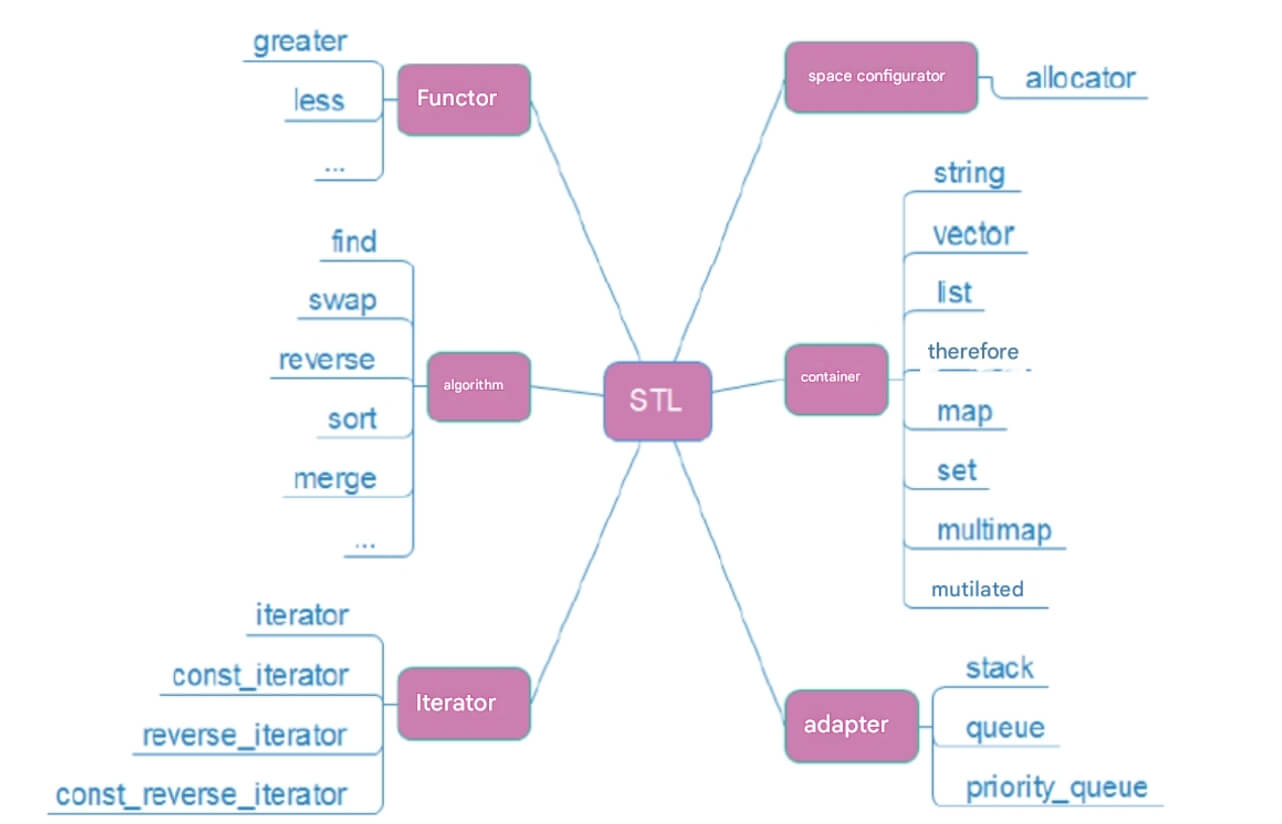The C++ Standard Template Library (STL) is one of the core parts of modern C++, providing developers with a rich set of predefined data structures and algorithms that greatly enhance programming efficiency and code readability. Understanding and mastering STL is crucial for C++ developers. Below is a detailed introduction to STL, covering its basic concepts, development history, core components, significance, and learning methods.
1. Basic Concepts of STL
STL (Standard Template Library) is a library in C++ that supports template programming with data structures and algorithms. The core idea is to achieve generality and reusability through templates, allowing developers to implement complex data structures and algorithms with simple interfaces.
STL is a model of generic programming, separating data structures from algorithms, so algorithms can be reused across different data structures. Iterators play a key intermediary role in this process, helping decouple algorithms from containers. For example, the sort function can sort both vector and deque because both can be operated on using iterators.
2. Development History of STL
STL has gone through several versions, each with unique features and applications. Here are some important versions of STL:
HP Version: Developed by Alexander Stepanov and Meng Lee at Hewlett-Packard Labs. This was the original version of STL, laying the foundation for modern STL, and it allowed free usage, modification, and extension.
P.J. Version: Developed by P.J. Plauger and adopted by Microsoft Visual C++. This version had closed source code and unique naming conventions, which made it harder to read and extend.
RW Version: Developed by Rogue Wave and used in C++ Builder. It inherited features from the HP version but also had closed source code and limited customization and extensibility.
SGI Version: Developed by Silicon Graphics Inc., it was widely used in GCC (Linux environments). This version was open source, highly portable, and had clear naming conventions, making it an important reference for learning STL.
3. The Six Core Components of STL
STL contains six core components, each of which plays an important role in C++ programming:

3.1 Containers
Containers are the various data structures provided by STL for storing and managing data. STL containers can be classified into several categories based on their usage scenarios:
Sequence Containers: Used for sequentially storing data, suitable for frequent insertions, deletions, and sorting operations.
vector: Dynamic array, supports random access, and efficient at inserting/removing elements from the end, suitable for scenarios that require heavy random access.std::vector<int> v = {1, 2, 3}; v.push_back(4); // Add an element to the enddeque: Double-ended queue, supports insertion and deletion from both ends.std::deque<int> dq = {1, 2, 3}; dq.push_front(0); // Add an element to the frontlist: Doubly linked list, efficient for insertion and deletion, suitable for frequent modifications.std::list<int> l = {1, 2, 3}; l.push_back(4);Associative Containers: Based on tree structures, automatically sorted with fast lookup.
set: A collection with unique elements, automatically sorted.std::set<int> s = {3, 1, 2};map: Key-value storage, with unique and sorted keys.std::map<std::string, int> ages; ages["Alice"] = 30;
Unordered Containers: Based on hash tables, supporting fast lookup, but elements are unordered.
unordered_setandunordered_map:std::unordered_set<int> uset = {1, 2, 3}; std::unordered_map<std::string, int> umap; umap["Alice"] = 25;Container Adapters: Wrappers for existing containers that provide specialized data management.
stack: Last-in, first-out (LIFO).std::stack<int> s; s.push(1); s.push(2); s.pop(); // Remove top element
queueandpriority_queue: First-in, first-out (FIFO) and priority-based dequeue.
3.2 Algorithms
STL includes many common algorithms used for operating on container data, primarily classified as:
Non-modifying Algorithms: Do not modify data, used for operations like searching and counting.
std::vector<int> v = {1, 2, 3, 4}; auto it = std::find(v.begin(), v.end(), 3); // Find an elementModifying Algorithms: Used for modifying data, such as
copy,replace.std::vector<int> v = {1, 2, 3}; std::replace(v.begin(), v.end(), 2, 10); // Replace 2 with 10Sorting Algorithms: Such as
sort,stable_sort,partial_sort.std::sort(v.begin(), v.end()); // Sort in ascending order
Numeric Algorithms: Such as
accumulate,inner_product.int sum = std::accumulate(v.begin(), v.end(), 0);
3.3 Iterators
Iterators are used to traverse containers. The main types of STL iterators include input, output, forward, bidirectional, and random-access iterators.
std::vector<int> v = {1, 2, 3};
for (std::vector<int>::iterator it = v.begin(); it != v.end(); ++it) {
std::cout << *it << " ";
}3.4 Functors
Functors are class objects that overload operator(), making them callable like functions. They allow custom operation logic in algorithms.
struct Multiply {
int operator()(int x) const { return x * 2; }
};
std::vector<int> v = {1, 2, 3};
std::transform(v.begin(), v.end(), v.begin(), Multiply());3.5 Adapters
Adapters change existing interfaces or functionalities to better suit specific purposes. STL includes container adapters, iterator adapters, and functor adapters.
std::vector<int> v = {1, 2, 3, 4};
std::reverse_iterator<std::vector<int>::iterator> rit = v.rbegin();
for (; rit != v.rend(); ++rit) {
std::cout << *rit << " ";
}3.6 Allocators
Allocators are responsible for memory allocation and deallocation in containers. The default allocator is std::allocator, but custom allocators can be created for resource optimization.
4. Importance of STL
STL is a milestone in C++ development, improving code reusability and development efficiency. After mastering STL, developers can quickly implement complex data structures and algorithms without reinventing the wheel. Understanding STL is considered a hallmark of advanced C++ programming. Experienced developers often say, “If you don’t know STL, don’t claim to know C++.”
5. How to Learn STL
Learning STL can be divided into three stages:
Being able to use it: Master the basic usage and familiarize yourself with common containers and algorithms.
Understanding the principles: Learn the internal implementation principles and analyze the advantages, disadvantages, and use cases of different components.
Being able to extend it: Customize and extend STL components, optimizing code according to specific needs.
When learning STL, it’s recommended to continuously consolidate knowledge by writing code and participating in online exercises (such as on NowCoder).
Conclusion
The C++ Standard Template Library (STL) is an outstanding tool in modern programming, simplifying C++ programming with its rich data structures and algorithms. Mastering STL not only improves development efficiency but also helps developers write efficient and elegant code. STL is an essential skill for every C++ developer, providing a solid foundation for smooth navigation in complex software development.



![[C++ Chapter] Setting Sail—An Introduction to C++ (Part 2)](/static/upload/image/20241120/1732094910609611.jpg)



